| Personal Notes | Home | Art | Profile | Critics page | Work available at | Contact | Copyright |
 |
VANDANA
SHUKLA born with the sensitivity of a poet, Vandana
has acquired this professional exterior of a journalist to protect
her fragility. It is when she comes across a good work of art, or
literature, that she finds a balance between the two.She loves exploring
an artist's mind through the journey she/he takes. |
Turning Tables On The Male Gaze
Nitasha not only paints the man, she re-creates his world, at times dream- like with tall buildings rising in the background, cars moving all around, at times hanging from a tree like man’s desire fruits. She explores the hidden, stubborn child behind this prototype who refuses to grow, a victim of societal creation of an image. The effort of this prototype to stay put into this image is both amusing and sad. No wonder, her works strike an instant rapport with both the genders! At some level, men and women both identify with this prototype.
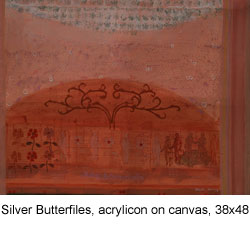 |
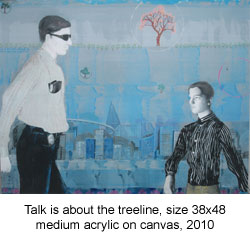 |
The artist does not like to be stamped as a feminist, in fact her works reflect compassion, humour and empathy for the other gender, who is struggling to come to terms with the equal status earned by the woman. “ I believe women are and will grow stronger by the day; urban women in India will be financially and emotionally more secure. But I ask: are Indian men ready for that? In my paintings and installations the office going man is the prototype of the city male: the slick clothing, the expensive bag, the imported shoes, the entire 'personality' is about pretence greed, power, dominance and total lack of emotion. There is no love, no caring; it is a life between "red traffic lights"( title of one of my works). The love of my life is a man, I paint him to celebrate him, I paint and install because I am angry at him for being insensitive. I create art so that some man somewhere will love and cherish a strong woman, instead of pitting his wits against her,” says the artist turning tables on the male gaze.
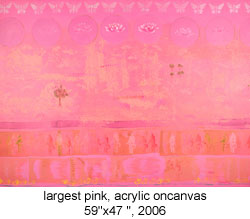 |
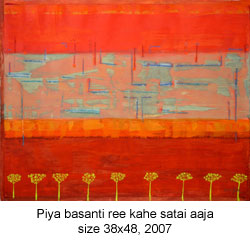 |
Nitasha is the third- generation empowered woman in her
family, which is reflected in the choices she made in her life and work.
The thought- process behind each of her themes is well conceived, analysed,
visualised and materialised. She is experimental in her mode and thought.
And, has sustained this quality over the years. The thread of one subject
is carried into many works, exploring several layers, till she steps into
the next exploration. For example, some people cut down a tree because
birds used to perch on the tree and their droppings would dirty their
cars. This happened in her neighbourhood at Gurgaon. The incident became
an inspiration for her series on birds and cars, making her explore several
layers behind this one incident. In one of the works a row of men raise
a car aloft like a trophy, and in another, cars are placed upon huge upright
poles and men latch on to, or hang from, them. In yet another work she
shows birds flying away leaving behind trees that blossom with cars. The
works made several statements; on our lack of empathy for the habitat,
selfishness, greed, and cruelty towards all that does not suit our immediate
agenda. She also cast cars in glass ,which she showed at Jehangir Art
gallery in Mumbai in 2004.
Nitasha paints only what affects and stirs her at a deeper level. She
has been painting the ‘other’- the man, since 90s, and the
image has evolved and changed with time. After she returned from her brief
sojourn in New Zealand in 2001, the overt physicality of her male figurations
began to disappear, giving way to hoards of faceless and identical, prototype
urban male figures. She also developed these painted figures into fibre-glass
mannequins for her installation show ‘Nayan Sukh’ in 2002
where she presented a full array of these prototype figures. These prototype
figures, produced as standard-size mechanical wares, became her artistic
signatures to convey the conventional rat- race and aspirations of the
modern urban men.
Though trained in oil colours, Jaini soon shifted to acrylic, a long stint
of training under Broota helped her blossom in her own style. In times
when the artistic world is jumbled with worries to level works with a
‘different’ tag, her works carry a kind of comfort with their
unique perspective. Her later works reflect horizontal layering ofminiature
paintings, the iconic here replaced by the prototype.
The Punjab born artist has shown her paintings and installations at almost
all prestigious galleries in India and a few abroad, dealing with subtle
power struggles of the mind and matter; within man, with woman, with nature,
speed, change and time. She also exhibited her works at Nomad gallery
in Islamabad in 2008.
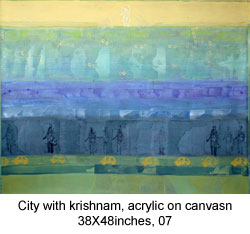 |
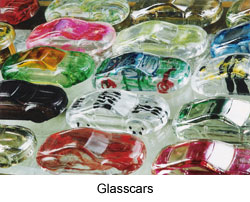 |
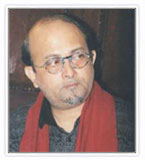 |
ROMAIN MAITRA is an art critic for ART INDIA art magazine and also writes on other visual and performing art forms as a free-lance writer. Apart from his pre-doctoral dissertation on the sociology of cinema, he has also written copiously on cinema in leading film journals including in ‘Cahiers du cinéma’. Formally he studied sociology and cultural anthropology and he is also an incumbent of a Senior Fellowship from the Ministry of Culture, Government of India. He was been affiliated with Maison des Sciences de l’Homme, Paris and was also a Consultant for culture at the UNESCO headquarters, Paris and a guest editor for its publication ‘The UNESCO Courier’. He has been writing for leading newspapers, magazines and journals in India and in Europe since almost three decades |
Nitasha Jaini paints only if she is led by an intense desire to do so. Her painting springs from the fount of a particular thought. Further, as she gives shape to her thought on canvas, the next element in the process is the application of colour. However, as the physical act of painting begins to set sail in the uncharted sea of the canvas, thought seems to disappear from the horizon and a solitary silence of a sailor takes over. This is the time for reflection and receding as she looks back at what she has done. The next phase of development occurs through adding and eliminating of the images that continually form in her mind and the theme or subject that she paints often gets extended over several paintings as she is wont to explore further the same subject from one painting to the next.
Although there had been different phases in her artistic journey, since the 1990s she had been fascinated with the ‘Other’ which, for her, is ‘the other gender’. Since little is unknown to her about her own gender, it is her gender’s counterpart that fascinated her. Thus, the conscious appeal of male human figures began in her paintings from 1990. These were external formulations of idealised male anatomy in her own artistic terms. However, over the years, she became more inclined to depict the psychological and social conditions of man as her prying eyes recorded impressions -- when she was out at large, or travelling in buses and trains -- while taking note of inter-gender relations and trying to look into the hidden layers within the males around her.
After Jaini returned from her brief sojourn in New Zealand in 2001, the overt physicality of her male figurations began to disappear, while giving way to fleets of faceless, and identical, prototype urban male figures. She also developed these painted figures into fibre-glass mannequins for her installation show ‘Nayan Sukh’ in 2002 where she presented a full array of these prototype figures. Ironically, if not very appropriately, she got this identical prototype figure made on a stamp with which she marked on the canvas and placed them in various ways. These stamped prototype figures, produced as standard-size mechanical wares, became her artistic signatures to convey the conventional rat race and aspirations of the modern urban men.
Apart from her romantic and mystic portrayals, her thoughts can be critical and often laced with humour too as she responds to the situations she witnesses around. But how do they germinate and take shape? Her works with cars ,being set in the grisaille of the fallen afternoon, evolved from an incident in her residential locality in Gurgaon. Near her home, there was a tree on which hundreds of birds used to perch and chirp around the whole day. But they also shed their droppings on the row of cars that were parked under the tree. So the angry bunch of car-owners got the branches of the tree chopped off and drove these winged larrikins away. This anecdote was followed by a series of her works on cars: in one, a tree is at the centre with very tiny cars hanging from its branches, in another, a row of men raise a car aloft like a trophy, and in another, cars are placed upon huge upright poles and men latch on to, or hang from, them. She also cast cars in glass ,which she showed at Jehangir Art gallery in Mumbai in 2004.
There are several visible layers, mostly horizontal and a few vertical as well, in the way she composes her tableau. Of these, some are manifest and prominent and some are not so much. She has also replaced brush with rollers that are applied on the colours being thrown on the canvas. Further, the large thick brush is replaced with thin, fine brushes that she wields like a pen as if to ‘write’ on the canvas. Miniaturisation is another aspect in her paintings. When she runs out of inspiration, she takes recourse to miniatures. She has been using the icon of Krishna on many occasions suggesting the Lord as a divine force. Even before her prototype-figure phase, there was often an iconic presence of divinity in her paintings. In some of her prototype paintings too, there are compositions in layers and the uppermost layer is given to the Blue god. Of late, she is also using images of lotus as a divine presence. Thus, in the multiplicity of her image-making of quotidian life, divine figures co-exist with the prototype figures and everything else. Some of her works of this genre of multiple layering were exhibited at the Gallery Nomad in Islamabad in 2008.
In this welter of artistic practices in India, the lonely sailor in Jaini has found her own distinct direction to address the looming horizon of modern urban living, of which she is a part, with tender humanism. To use her own words, “My work is first and foremost a fulfilling and joyous experience for me. Drawing, feeling, experiencing, deriving, rejecting, re-forming, and selecting all these, and much more of said-unsaid, go into my painting… As a woman, the male has played an important role in my life-experiences. A sympathetic and compassionate view has enabled me to get a glimpse of this vulnerability, sensitivity, and the emotional content of this temperament, which is seething under the immense pressure of ‘better performance each time’, rules over our overly materialist urban society. These experiences are the core of my paintings. As an empowered woman of the 20th century, I do understand his helplessness and anxiety at the changing, traditional gender roles of the urban society, but then, the wheel of progress must never be reversed and, therefore, men themselves will have to shed their ‘macho’ image and face this challenge, with grace.
ROMAIN MAITRA
|
||||||||